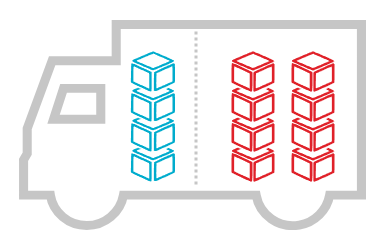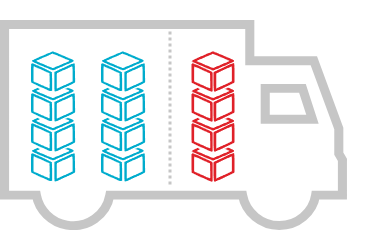Characteristic
Short description
The user can state for every vehicle![]() The term vehicle describes what is being routed or planned for. Vehicles are used in route calculation, distance matrix calculation and effectively also in tour planning. In route calculation, vehicle properties like overall size, weight and speed are in focus. In tour planning, it is vehicle properties like capacity and availability.
Commonly a vehicle is motorized, like a truck - including its trailer or a car. However also a bike or even a pedestrian are included in this definition. that one compartment can only be accessed through another compartment, the 'walk-through' compartment.
It may happen that this access is blocked by loaded goods in the walk-through compartment.
With the compartment access restriction, it can be specified when the walk-through compartment is too crammed to be able to reach the other compartment.
The term vehicle describes what is being routed or planned for. Vehicles are used in route calculation, distance matrix calculation and effectively also in tour planning. In route calculation, vehicle properties like overall size, weight and speed are in focus. In tour planning, it is vehicle properties like capacity and availability.
Commonly a vehicle is motorized, like a truck - including its trailer or a car. However also a bike or even a pedestrian are included in this definition. that one compartment can only be accessed through another compartment, the 'walk-through' compartment.
It may happen that this access is blocked by loaded goods in the walk-through compartment.
With the compartment access restriction, it can be specified when the walk-through compartment is too crammed to be able to reach the other compartment.
Use
This technical concept explains the options for the feature 'compartment access restriction' in more detail by means of an example.
Detailed Consideration
Suppose there are two compartments in a vehicle, one of which cannot be reached from the outside. Instead, there is a door in the wall that separates the 'separate' compartment from the 'walk-through' compartment. In practice, the door in the wall may be unreachable when the walk-through compartment is too crammed. If that happens, the separate compartment cannot be accessed anymore and no goods can be picked up or deposited there.
In the following, this feature is explained by means of an example. We start with a very basic setting that evolves in three steps.
1. Two temperature zones
In our example, we have one vehicle with two compartments that differ in their temperature - cool and warm. Correspondingly, we have goods that either need to be transported in the cool or in the warm compartment. For the sake of simplicity, we assume that all goods are packed into containers, and we do not need to consider weight or volume but only the number of cool and warm containers. We store- the number of cool containers at index 0 and the number of warm containers at index 1 in the quantities of the transport orders,
- the maximum number of cool containers at index 0 and the maximum number of warm containers at index 1 in the quantities of the (only) maximum quantity scenario of the vehicle.
- Compartment A is index 0 and
- Compartment B is index 1.
- Quantities are (4,8),
- Compartment setup is ACCESS_A_THROUGH_B.

Finally, we assume the separate compartment can only be reached when there are no more than 4 containers (=50%) in the walk-through compartment and specify the load threshold for the compartment access restriction of the vehicle as follows:
Example instance
We have to pickup containers at the customers C1, C2, C3 before we deliver them to the depot.
| Pickup at C1 | Pickup at C2 | Pickup at C3 | |
|---|---|---|---|
| Cool (A) | 1 | 1 | 1 |
| Warm (B) | 2 | 2 | 2 |
| Load after pickup | (1,2) | (2,4) | (3,6) |
| Load ratio in B | 25% | 50% | 75% |
The load in the vehicle is (1,2) after leaving C1 and (2,4) after leaving C2. Still, the walk-through compartment is not crammed yet as it is filled to exactly 50% and not more. At C3, the compartment access restriction is not violated as the cool containers can be loaded before the warm containers. However, if the load threshold was less than 50, there would have been a CompartmentAccessViolation. At the depot, the compartment access restriction is again not violated as the warm containers can be unloaded before the cool containers.
2. Temperature zones can be swapped
Suppose the temperature in the compartments can be changed and we could as well put the cool containers into the walk-through compartment and the warm containers into the separate compartment. In this setting, we need a second maximum quantity scenario for the vehicle. We set the quantities and the compartment setup in the second maximum quantity scenario of the vehicle as follows:
- Quantities are (8,4),
- Compartment setup is ACCESS_B_THROUGH_A.

In case of swapped temperature zones, we want all cool containers to be unloaded before warm containers are picked up or delivered. Consequently, we define the other load threshold differently:
Example instance
This time, we pick up containers at the depot and deliver them to the customers C1, C2 and C3.
| Delivery to C1 | Delivery to C2 | Delivery to C3 | |
|---|---|---|---|
| Cool (A) | 3 | 2 | 0 |
| Warm (B) | 0 | 1 | 2 |
| Load before delivery | (5,3) | (2,3) | (0,2) |
| Load ratio in A | 62.5% | 25% | 0% |
The load in the vehicle after leaving the depot is (5,3). At this point, it is clear that the first maximum quantity scenario is not feasible capacity-wise while the second scenario still is. At C1, we do not need to access the warm compartment and thus do not need to check the compartment access restriction for the second scenario. At C2, the cool containers are unloaded first such that when the warm containers are unloaded the cool compartment is empty. And it stays empty until the end, so the load threshold of 0 is never exceeded.
3. Separating wall is movable
Suppose the separating wall can split the whole cargo area either at 1/3 or at 2/3. Then we need two more maximum quantity scenarios than the two already defined before. We set the third maximum quantity scenario of the vehicle as follows:
- Quantities are (8,4),
- Compartment setup is ACCESS_A_THROUGH_B.
- Quantities are (4,8),
- Compartment setup is ACCESS_B_THROUGH_A.


Example instance
Again, we pick up containers at the depot and deliver them to the customers C1, C2 and C3.
| Delivery to C1 | Delivery to C2 | Delivery to C3 | |
|---|---|---|---|
| Cool (A) | 3 | 2 | 0 |
| Warm (B) | 1 | 1 | 1 |
| Load before delivery | (5,3) | (2,2) | (0,1) |
| Load ratio in B | 75% | 50% | 25% |
In this example, only the third maximum quantity scenario is feasible. The load in the vehicle after leaving the depot is again (5,3). At C1, 1 warm container is delivered first, leaving only 2 (=50%) warm containers in the walk-through compartment. From this point on, the load threshold of 50 is never exceeded.
Good to know
Quantity Scenario Change Position
With a compartment access restriction, it is common to have more than one maximum quantity scenario. Such a maximum quantity scenario can change. By default, it can change between trips but it could as well be at each stop, depending on the quantity scenario change position.
Related Topics
| Technical Concept | Multiple Maximum Quantity Scenarios |